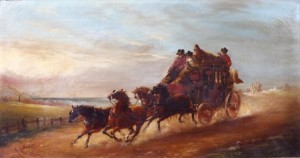Until the 1840s time in Oxford, and therefore at the University Press, was five minutes behind that of London. With no uniform national time until the coming of the railways and the telegraph, the sealed clocks carried by mail coaches would have to be adjusted to Oxford or London time as they were shuttled between the two cities.
 As early as 1669 there had been a daily coach service to London, which completed the journey in 12-13 hours at an average speed of 4.8 mph — at least in summer — at a cost of 12s (60p) per passenger. That was very expensive fare indeed. In 1710 a skilled man in the building trades, say a carpenter, would take more than a week to earn such a sum. There was also a substantial carrier service operating wagons between Oxford and London, commonly at a speed of around 2 mph or less. However, by 1789 the old road to London via Cheney Lane and Shotover Hill had been abandoned in favour of a new turnpike route via Headington, which now forms part of the present A40. The turnpike was abolished in 1878 as revenue declined through competition with the railways. It was this new London Road that encouraged a proliferation of faster and more frequent coach services. By 1828 the journey time between Oxford and London for passengers was down to six hours. In 1835 there were at least seventeen coach services from Oxford to London on most days including the Royal mails at midnight, ‘Rocket’ at 3 a.m., ‘Defiance’ at 10 a.m., ‘Tantivy’ at 2 p.m. (all via Henley); and ‘Retaliator’ at 11 a.m., ‘Champion’ at 11 p.m., and ‘Paul Pry’ at midnight (all via Wycombe and Uxbridge).
As early as 1669 there had been a daily coach service to London, which completed the journey in 12-13 hours at an average speed of 4.8 mph — at least in summer — at a cost of 12s (60p) per passenger. That was very expensive fare indeed. In 1710 a skilled man in the building trades, say a carpenter, would take more than a week to earn such a sum. There was also a substantial carrier service operating wagons between Oxford and London, commonly at a speed of around 2 mph or less. However, by 1789 the old road to London via Cheney Lane and Shotover Hill had been abandoned in favour of a new turnpike route via Headington, which now forms part of the present A40. The turnpike was abolished in 1878 as revenue declined through competition with the railways. It was this new London Road that encouraged a proliferation of faster and more frequent coach services. By 1828 the journey time between Oxford and London for passengers was down to six hours. In 1835 there were at least seventeen coach services from Oxford to London on most days including the Royal mails at midnight, ‘Rocket’ at 3 a.m., ‘Defiance’ at 10 a.m., ‘Tantivy’ at 2 p.m. (all via Henley); and ‘Retaliator’ at 11 a.m., ‘Champion’ at 11 p.m., and ‘Paul Pry’ at midnight (all via Wycombe and Uxbridge).
By 1854, in the face of competition from the railways, the array of coach services to London that had been available in the 1820s and 1830s had shrunk to just three a week. However, carriers still operated successfully, though commonly over shorter distances, by adapting to the railways and offering fill-in services to get people and goods to and from the nearest railway station. As late as 1883 there was still a multitude of carriers serving Oxford and the surrounding area.
On 11 April 1843, royal assent was given to a bill that provided for the building of a broad gauge branch line from Didcot to Oxford, terminating at a station by Folly Bridge (Grandpont). By 31 August 1843 the Oxford Railway Company’s £120,000 share issue had been fully subscribed. The mild winter of 1843-4 that followed allowed rapid progress with construction, and by 14 June 1844 the railway was open to the public. A timetable in January 1845 offered a service of nine trains a day to and from London with a journey time of around two and a half hours as opposed to the six hours taken by the fastest coach. Almost all services required that passengers alighted at Didcot and picked up the express services from Exeter and Bristol into London. Ticket prices were high: 15s (75p) for first class, 10s (50p) for second class, and 5s3d (26p) for third class; transporting a horse cost 32s (£1.60), and a four-wheeled carriage 36s (£1.80). The price of a coach journey to London, on the other hand, by this time was just 5s (25p). However, the disposable weekly income of a carpenter in the 1840s would have been no more than 3s (15p) at best. We tend to forget just how expensive travel was in the past.
Simon Eliot is Professor of History of the Book at the Institute of English Studies. He is the general editor of The History of the Oxford University Press.
This post also appears on the OUP Blog (http://blog.oup.com/2013/12/oxford-london-coach-service-18th-19th-century/)

